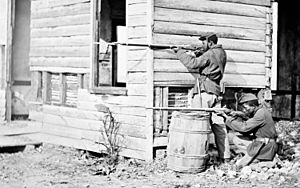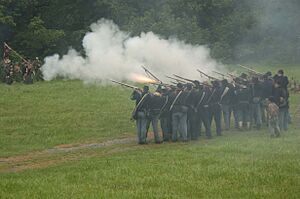5th United States Colored Cavalry Regiment facts for kids
Quick facts for kids 5th United States Colored Cavalry |
|
|---|---|

African-American Union soldiers at Dutch Gap, Virginia, November 1864. It shows typical Union uniforms and the 1853 Enfield rifles used by US Colored Troops
|
|
| Active | 1864–1866 |
| Country | |
| Allegiance | Union |
| Branch | Cavalry |
| Size | Regiment |
| Engagements | American Civil War |
| Commanders | |
| Notable commanders |
James Sanks Brisbin Louis Henry Carpenter |
The 5th United States Colored Cavalry (USCC) was a special group of soldiers in the United States Army. They were part of the United States Colored Troops during the American Civil War. This cavalry unit was known for its bravery and important actions.
The 5th USCC was officially formed in Kentucky in October 1864. However, they had already fought in two battles before this official start. Colonel James Brisbin led the regiment first. Later, Louis Henry Carpenter took command until March 1866.
Many soldiers in the 5th USCC were former slaves or free African Americans. Some white officers from this unit later joined the famous Buffalo Soldiers. These were other African-American cavalry units who fought in the American West. This regiment is different from the 5th Massachusetts Colored Cavalry.
Contents
Forming the 5th USCC
In early 1864, General Stephen Gano Burbridge was in charge of the military in Kentucky. He gave an order to create units made up of African-American soldiers. These soldiers were formerly enslaved people or those who had escaped to freedom.
Even though the 5th USCC was not officially formed until October 24, 1864, they fought in battles before then. Their first big fight was on October 2, 1864, near the salt works in Saltville, Virginia. Over 600 African-American soldiers joined General Burbridge for this raid.
All the officers in the 5th USCC had to be white. Black soldiers could become noncommissioned officers (NCOs) like sergeants. But Lieutenant Colonel L. Henry Carpenter saw that many of his new black troops could not read or write. So, he asked for white NCOs to help lead the units. His request was approved.
The unit was put together very quickly. Some soldiers had not officially joined the army yet. Few officers or NCOs had been properly assigned. Colonel James F. Wade was put in temporary charge. He was ordered to join General Burbridge in Kentucky.
In his rush, Wade gave his 600 men untrained horses. He also gave them Enfield infantry rifles. These rifles were not good for soldiers on horseback. They were hard to load while riding. Other Union cavalry units had Spencer repeating carbines. These were much better for fighting from horseback.
General Grant had ordered General Burbridge to go into southwest Virginia. His mission was to destroy the important salt works at Saltville. The 5th USCC joined Colonel Brisbin's forces. They met Burbridge in Prestonburg, Kentucky.
Burbridge left Prestonburg on September 27 to march towards Saltville. White troops sometimes treated the black soldiers badly. They would make fun of them or steal their horses. But the black soldiers always acted professionally.
Battles for Saltville
The 5th USCC fought in the First Battle of Saltville from October 1 to 3, 1864. They were part of the Union forces led by General Stephen Gano Burbridge. The cavalry tried hard to break through the Confederate lines. But they were pushed back many times. The Union forces lost this battle.
After the battle, some Confederate fighters attacked wounded Union soldiers. These attacks happened to members of the 5th USCC who were in hospitals. A Confederate leader named Champ Ferguson was arrested after the war. He was tried for these attacks in Nashville. He was found guilty and sentenced to death. Ferguson was one of only two men executed for war crimes during the Civil War.
Stoneman's Winter Raid of 1864
In December 1864, General George Stoneman ordered the 5th USCC to join a raid. This raid went from East Tennessee into southwest Virginia. The 5th USCC fought in several battles during this raid. These included fights at Hopkinsville, Kentucky on December 12. They also fought at Kingsport, Tennessee on December 13.

They fought in the Battle of Marion near Marion, Virginia, on December 17 and 18. Finally, they fought in the Second Battle of Saltville on December 20 and 21. All these battles were considered Union victories.
Battle of Marion
During the Battle of Marion, General Burbridge placed the 5th USCC between two white units. They were on the left side of the Union battle line. Lieutenant Colonel James S. Brisbin and Carpenter led their soldiers forward. The soldiers were fighting on foot towards the Confederate defenses.
The Confederates fired heavily at the Union troops. They used four large cannons. The first Union attack failed and fell back. Carpenter ordered his men to regroup and try again. The 5th USCC charged forward with a loud yell. They tried to break through the enemy's defenses but could not. Carpenter then told his men to dig in for the night. Volunteers went out to rescue wounded soldiers between the lines.
On December 18, the next morning was cold, rainy, and foggy. The second day of fighting was like the first. The Union forces attacked many times. The Union center managed to break through the Confederate defenses. But the Confederates quickly counterattacked and pushed them back.
Carpenter led a group of African-American soldiers on horseback. They tried to rescue white soldiers who were trapped near a bridge. Carpenter tried several times but could not save them. Most of those trapped soldiers were captured later that day.
Later, Confederate reinforcements attacked the Union's left side. The white unit next to the 5th USCC was completely defeated. This put the 5th USCC's side in danger. Carpenter and Brisbin were ordered to fall back. They tried to make an orderly retreat. Many African-American soldiers remembered the attacks on their wounded friends at the First Battle of Saltville. They broke ranks to rescue their wounded comrades. The retreat almost turned into a complete defeat.
Around 4 PM, more Union soldiers arrived. They strengthened the Union line. During the night, the Confederate forces had to leave. They had run out of ammunition. The next day, Union soldiers buried the dead and helped the wounded. This difficult victory was a major success for Stoneman's raid.
Second Battle of Saltville
On the afternoon of December 20, Union forces attacked Saltville, Virginia, again. The Confederate forces were overwhelmed. The 5th and 6th USCC units joined the fight with great determination. The outnumbered Confederates retreated. They waited for more soldiers to arrive.
Union forces quickly tried to destroy the important salt works. They destroyed about one-third of the boiling kettles. They also ruined most of the sheds used for drying salt. Parts of the Virginia & Tennessee railroad were also damaged. But they could not destroy the salt wells themselves. General Stoneman claimed victory. He then left Virginia before the Confederate forces could surround him. Within three months, the Confederates had the salt works working fully again.
Ambush at Simpsonville
On January 23, 1865, 80 African-American soldiers from Company E of the 5th US Colored Cavalry were given a task. Led by 2nd Lieutenant Augustus Flint, they had to move almost a thousand cattle. The cattle were going from Camp Nelson to Louisville, Kentucky.
On January 25, about 41 men were at the back of the cattle herd near Simpsonville. They were suddenly attacked by Confederate guerrillas. Few Union soldiers could fire their Enfield infantry rifles. The gunpowder was wet, making the guns useless.
The guerrillas had 6-shot revolvers. Most carried two or more. They quickly got close to the Union soldiers. Almost all the African-American soldiers at the back were wounded or knocked off their horses. Only two escaped harm. One pretended to be dead, and the other hid under a wagon. The soldiers at the front of the herd panicked and ran away.
About an hour after the attack, local people found 15 dead soldiers. They also found 20 wounded soldiers on or near the road. Four more soldiers were found dead later from wounds or the cold. The people of Simpsonville took 20 wounded men back to town. Eight of them were so badly hurt that they were not expected to live. Six more soldiers died on the way to or in Louisville.
Later, it was found that 19 Union soldiers had been killed after trying to surrender or after being disarmed. The rest of the wounded Union soldiers were left to die in the freezing cold. Three soldiers were never found.
Lieutenant Flint, who was in town during the ambush, fled to Louisville. Authorities sent a message to Camp Nelson. Carpenter immediately sent ambulances. A strong group of soldiers on horseback arrived on October 28. They took the surviving wounded to a hospital in Louisville.
Local people told what had happened. They also reported that the Confederate guerrillas, led by Captain Dick Taylor, had bragged about killing many Union soldiers after capturing them. A mass grave was found. Carpenter wrote a report and listed the names of the known guerrillas. He wanted them to be hunted down and punished, but this never happened.
A memorial marker was put up in 2009. It remembers the ambush and the killing of these US Colored Troops.
End of the 5th USCC
The 5th USCC stayed on duty for almost a year after the Civil War ended. The Army of Northern Virginia surrendered at Appomattox Court House. On March 16, 1866, the 5th USCC had its final gathering in Helena, Arkansas. This event honored the 50 soldiers who went missing during the First Battle of Saltville.
Historians believe that the African-American soldiers who were attacked at Wiley Hall might be buried at Holston Cemetery. This has not been proven.
Battles of the 5th USCC
Here is a summary of the battles the 5th USCC fought in:
1864
- October 2 - Saltville, Virginia - Battle of Saltville I
- October 21 - Harrodsburg, Kentucky - a small fight
- December 12 - Hopkinsville, Kentucky - a small fight
- December 13 - Kingsport, Tennessee (flanking movement and skirmishing)
- December 17–18 - Marion, Virginia - Battle of Marion
- December 20–21 - Saltville, Virginia - Battle of Saltville II
1865
- January 25 - Simpsonville, Kentucky - an ambush
|


